What are they tuning, a fog harp?
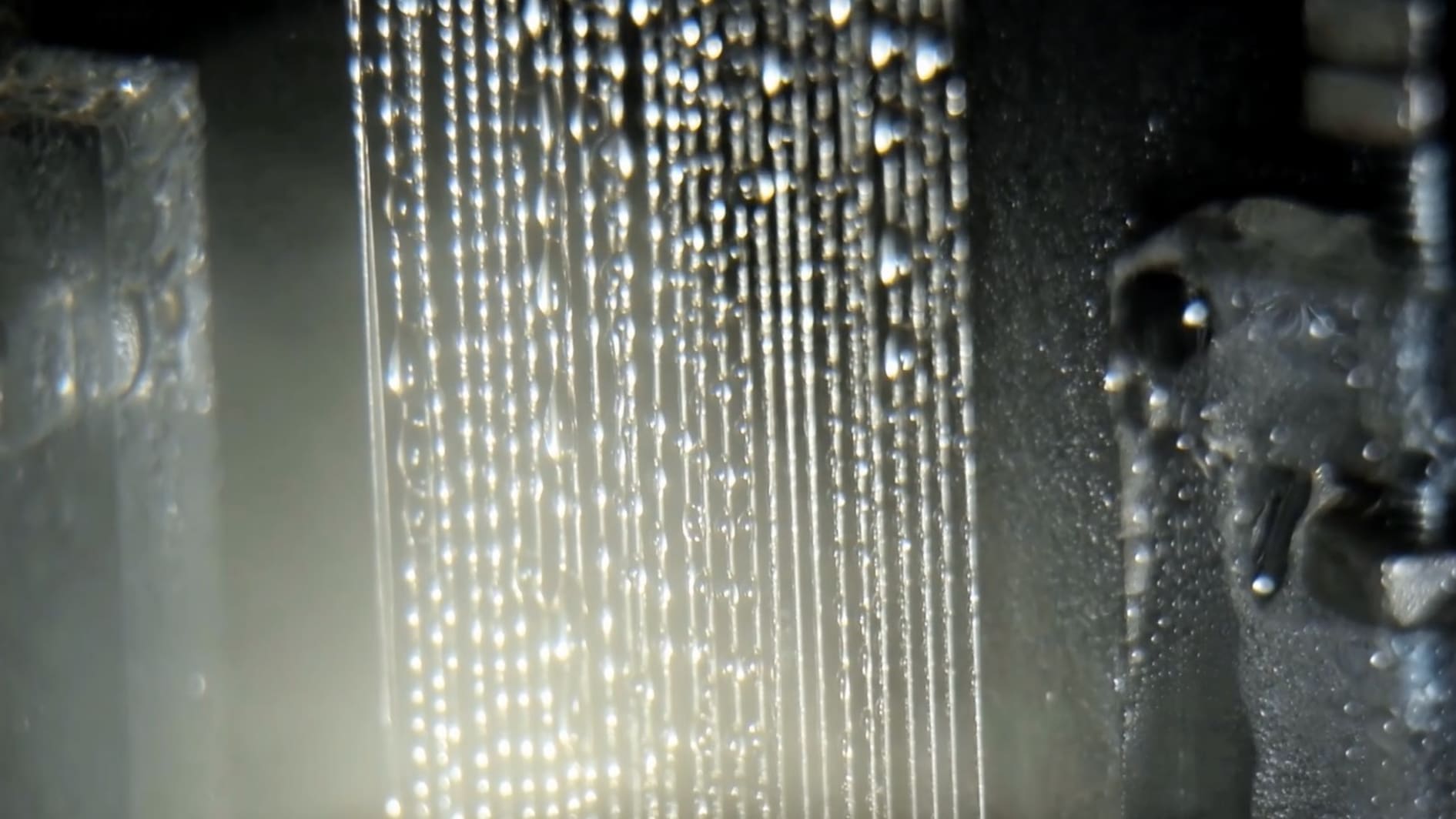
If you’re as old as I am and like the same music, you may recognize that title. It was a line uttered by Kurt Cobain just before launching into a song in 1993 (minus the word “fog”, which I added for this post). A band called the Meat Puppets had just joined Nirvana on stage for some songs and they were taking a while getting their guitars ready. Thus, that “What are they tuning, a harp?” comment appeared at the beginning of a song on Nirvana’s MTV Unplugged album.

Source: MTV.com
Why am I writing about harps? Because that is what scientists at Virginia Tech call their latest invention, the Fog Harp. It is a device that pulls water from air. When fog is blowing through an area, this device can harvest that water from the air. It’s like sticking a big fishing net up in the air and catching the tiny water droplets. Given that many areas of the world have limited access to fresh water, I think the Fog Harp is a great title for a great invention (more on that below).
Nature Did It First
But as with many other inventions, nature did it first. To prove this point, I give you the Coast Redwood. Redwoods and other related coniferous trees (pines, firs, spruce, etc.) are some of nature’s most efficient water harvesters. They can pull water from thin air, or at least from the foggy air that often fills the skies for months at a time along the coasts of Northern and Central California.
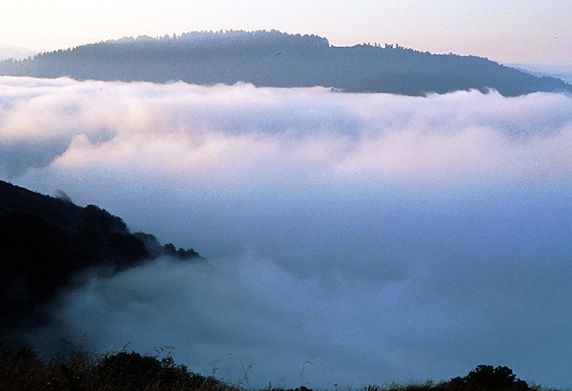
Below is a time lapse video of fog rolling through this region. You can see what amazing potential there is for trees to collect some of the water from this air:
Underneath the tree’s canopy on a foggy day with the wind blowing, you’d be excused for believing you are in the middle of a Pacific storm. When the low fog clouds sweep in, you often cannot feel the water at all because it’s not condensing into droplets; fog is like a cloud of cool steam. But under a big conifer tree such as a redwood, on a very foggy night, it is quite literally raining as much as in any storm. That’s how much water is being captured and dripped down towards the tree’s roots.
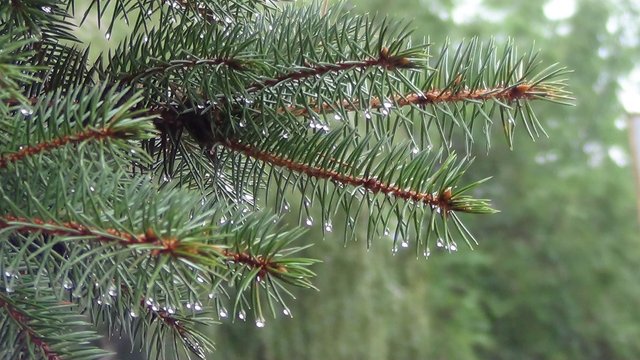
I know because I used to live near the foggy coast of Northern California in a house that had a huge redwood tree looming overhead. It was quite frightening during a real storm with high winds. For all the noise that tree made, we were lucky that nothing more than small branches ever fell down because the tree was much larger than the house.
But that tree made plenty of summer days seem like stormy days by raining down water from the coastal fog that came in each morning and evening. If it had never rained a day there, that tree would have had plenty of water because the thin foggy air gave it everything it needed. And I didn’t need to water the garden for more than a few days per year either, since that tree did it for me.
Some of these trees are so big you can drive through them.

Source: Visitredwoods.com
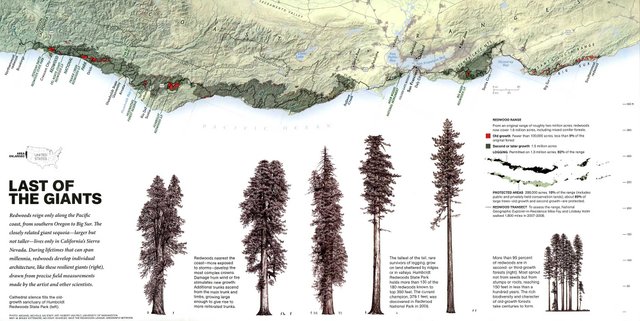
While the closely-related sequoia trees occur inland in the Sierra Nevada mountains, the range of coast redwoods is very limited today. Source: National Geographic.
How do these trees capture so much water from the air? They use their branches and needles as a harvester. Redwoods first appeared just after the time of the dinosaurs and some of these individual trees have been alive for millennia. The oldest ones are 2,200 years old. It is amazing to stand beneath these old growth giants and realize that a few of them may have been standing there since before the time of Julius Caesar, Jesus Christ, or the prophet Muhammad.
Here is another picture of the needles a coniferous relative of the redwood tree (I think this one is a pine). Look at how the needles trap even the smallest water droplets and let them combine until their weight drops them right down to the trees’ roots. It’s a brilliant system and also very simple.
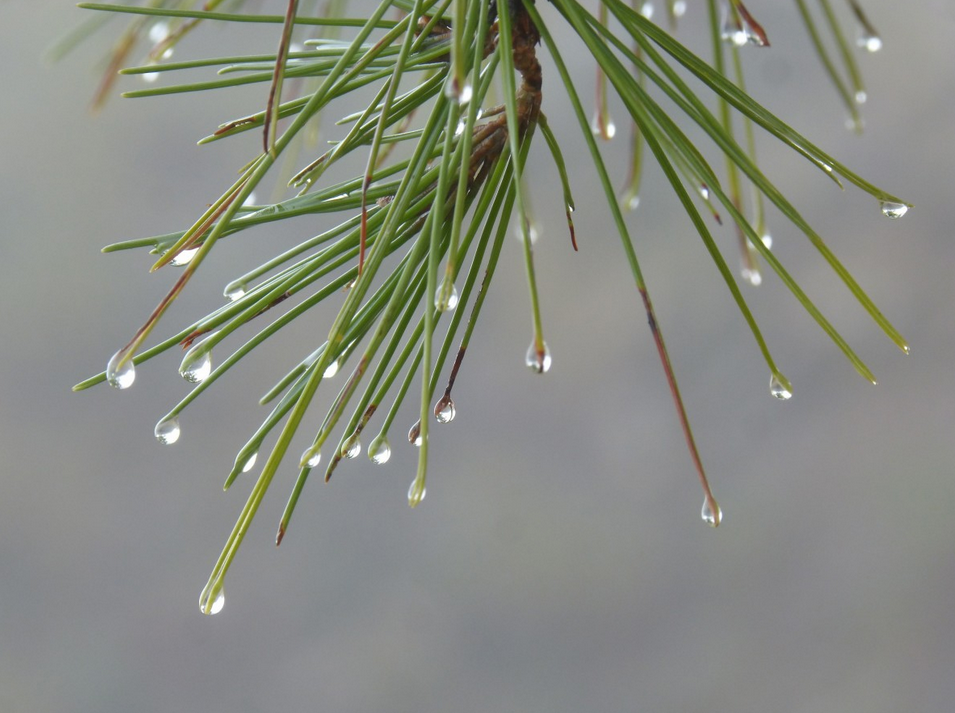
Water Harvesters Made by Humans
Using a similar system, humans have been collecting water from fog for many years. In areas that are arid but get some fog, the simplest method is to sink two posts into the ground and string a mesh net between them. The wind blows the fog through. This method is used in Morocco and in the Andes of South America where fog often forms.
Small water droplets are caught in the mesh. Gravity forces them to combine with others to form larger drops that fall to the ground, where they can collect in a trough or container. It’s like putting the same net in a river until enough fish swim into it that you have a meal. The best fishing grounds are coast-facing hills or mountain ranges with a propensity for foggy weather where that marine layer is blown towards shore by prevailing winds.
Here is a fog harvesting project in Lima, Peru:
There are more complex designs as well, such as multi-story towards of nets, cube designs, swirly designs, and so forth, some of which may catch slightly more than the simple method of hanging a net curtain on two poles.
The Fog Harp
One of the problems with traditional collectors is that they cannot catch too much at any one time. Either they are not very efficient at delivering small drops downward or water gets stuck because of the horizontal mesh lines, which impedes the ability to collect more droplets from fog. So, scientists at Virginia Tech University worked to find the most efficient design.
This turned out to be a set of wires which are held taught by a frame. Each vertical wire can catch water from even tiny droplets in the foggy air, delivering them down to the reservoir where the water is collected. The overall efficiency is better than a simple catch net.
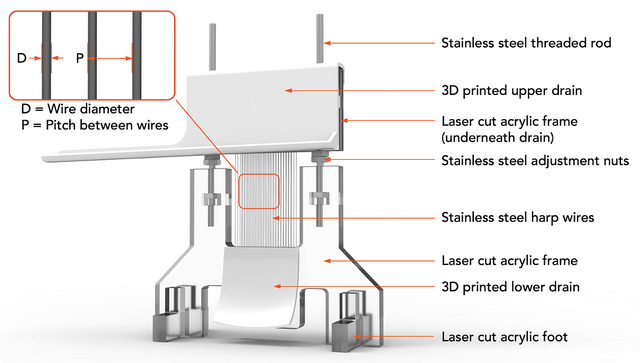
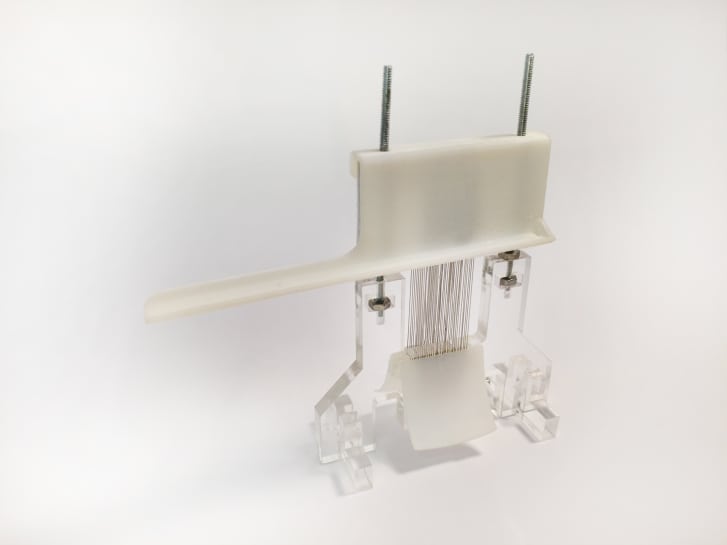
Fog Harp images courtesy of Virginia Tech University.
In fact, the Fog Harp can collect three times as much water as other systems. As with any new invention, it probably needs more testing, but this is not an elaborately complex device. And once the Fog Harp is produced as a workable product, hopefully the cost will be affordable for people in developing countries. These fog harps could help deliver clean drinking water to areas that may not have it, as long as they have fog.
What sound does this harp make when it’s tuned? Drip, drip, drip.

Sources:
https://en.wikipedia.org/wiki/San_Francisco_fog
www.climatetechwiki.org/content/fog-harvesting
https://www.cnn.com/style/article/fog-harp-virginia-tech/index.html
https://vtnews.vt.edu/articles/2018/03/fog-harp-increases-water-collection-capacity.html
Top image shows fog harp and is courtesy of Virginia Tech University. Other images are public domain unless indicated.
That was a good read. I find it so interesting how some of the best inventions are just ways in which humans create devices that mimic nature.
When I was reading the first few paragraphs I was thinking, “there are already lots of plants that do this” and then right on cue, you talked about how nature does this.
I loved going through BBC’s “Blue planet” (not sure on the name) documentary and then they released a second one. Nature is full of amazing things we can learn from and has adapted so well to life on earth.
I recently listened to a radio lab podcast titled “smarty plants” I recommend giving this a listen if you are interested in some of the marvelous things in nature that we don’t really understand.
Tip! Hide
Absolutely. I love those Blue Planet and earth documentaries also. The world we live in is quite inspiring.
that tech. might have some negative effect, if we use it in a large scale it could disrupt the nature of water cycle and could potentially create a climate change.
Perhaps, if it's on a large scale, though I doubt these amounts of water make too much difference to the climate at the moment. Also, if you watch that video clip from the existing project in Peru, they have to hire water trucks to bring water up to those towns. That's plenty more pollution, etc. which worsens climate issues. Plus, when people use water, it's for consuming or washing, and either way that water does not disappear from the environment; it is cycled back in, probably not far from where it was when it was taken from the clouds. I don't know the overall impact of this, but I suspect it's minimal unless done on a much larger scale.
Hello @donkeypong a great greeting, I am new to your blog and observing several of your publications I was delighted with them, I liked your blog and your publications as you publish a bit of everything, and write information that is very informative, educational and above all very smart. Personally I love sports, so every post you made about sports I liked a lot, like the others too, your blog is fantastic. I will follow you and from now on be aware of your posts, to continue enjoying the good things that you make us arrive in your publications. For now I say goodbye wishing you have an excellent weekend and that you are very well. I send you a great greeting from Venezuela.
Amazing read... I had no idea about the invention of the scientists at the Virginia Tech University but I've seen water collected on plants like that.
Good stuff.
But I have a concern, we are known to overdo things as humans. Now, I'm pretty sure these plants take just the right amount of water from the fog, I fear this manmade invention might take more than it should leave the atmosphere, thus upsetting the balance of nature (I don't really have much if science knowledge in this regard, so forgive me if it seems baseless)
That seems to be a common concern in these comments. I don't know the answer, but I suspect the amounts taken are relatively minor overall, unless this technology were to be deployed on a much larger scale.
This would be really handy in the northern part of my country during the harmattans.
At that time of the year, there is no rain and fog usually rolls over the land at night and early in the morning before the sun comes out.
It would be quite beneficial as the northern part of my country does a lot of farming but do not have much water compared to other parts of the country.
Thanks for the comment. I was not familiar with the term, so I looked upo "harmattans". Sounds like this kind of tech might be useful there.
yes, greatly @donkeypong. I actually moved to the north recently. I am from the southern part of Nigeria, so I am used to seeing rivers flowing all time of the year as well as rains falling heavily during the rainy season.
The north doesn't have such luxuries. When the dry season starts lots of their water reserves drops and since they are mostly farmers producing farm produce like tomatoes, pepper, onions, millet, etc the lack of water affects their output. A tech like the fog harp would definitely be a good support for farmers.
Also the Sahara is slowly eating into arable land and areas that used to be green are slowly turning to dust due to the lack of proper irrigation as well as trees. Also cattle has played a role in the deforestation. So indeed, a fog harp, any tech to improve water supply would do farmers and cattle herders in the north great good.
I think I am repeating myself but the post has given me much to think of as I have never really thought about it... Lol. Thank you for reading comment, I enjoyed the post.
Your explanation about adapting to the environment, especially treating water and air is very complete. Water has always been a major issue in many places in world. Including in Indonesia. In fact, in an area in Indonesia, namely in Gunung Kidul, Yogyakarta, if the dry season, people have to buy water with expensive prices. Gunung Kidul is one of the areas in Indonesia that has water problems. Until now the problem has not been resolved. Thank you for sharing mr @donkeypong
To an outsider like me, your country seems so green and lush, but it's also very diverse geographically, so that's interesting to hear of the dry area you mention. Maybe this can help, but it does depend on there being some moisture in the air.
There are many villages in Indonesia which are experiencing severe drought every year. Usually the drought is against in July, August, September. Gunung Kidul, Yogyakarta, including one of the worst areas experiencing drought. People lack water. Plants are also dry. The drought is still a threat in some villages. That is because Indonesia is also hit by the dry season. This news can be one of the references to drought in Indonesia Thousands of Central Java villages threatened by drought.
The tech does look interesting, but i have a slight worry, i can probably solve it by doing some extra research and maybe my worry is completely stupid and out of place but what if you start taking so much water from the air that at some point you remove the moisture from the air and the air turns hard and dry like desert winds? but that can't possibly happen right? as i said, pretty cool tech but i'll do the research but thats the first thing that came to my mind as i read this for some reason.
That was an awesome invention extracting water from air or I may say from the fog. I think, just a little modification of this technology, it can be used in the few water areas or in places that is hard to get clean water. There are part of the world that is lack of clean water and even dont have any pump to extract water from earth - this kind of invention maybe works in this places.
Yes, it's like cloud seeding (inducing rain), which works to a small degree in some places. Both seem to rob the air of some of its moisture. What is the effect on nature? I don't know the answer. It may be a relatively small amount of water, considering what it up there.
I saw a show once where they built a device that sucked water out of the air... but then it failed to distinguish between water in the air and water in people, and it just started sucking people dry.
Probably not a real risk here either ;)
Sounds like my vacuum cleaner.
Distinct from my cousin Vac, who is a cleaner... that guy just sucks the fun out of everything.
I guess that it depends on the amount of machines you are running in a certain place, a dozen and so would probably not cause damage, but if you start setting them up like solar panels by the hundred is going to have consequences too, but it looks like a great method anyways for places with no water and far away from the ocean.
If you have no water but are close enough to the ocean i prefer water desalination technologies.
Quite interesting, I have always considered that the inventions that human beings make are always inspired by phenomena of nature, we replicate it in the most efficient and cheapest way possible. Hopefully this project will meet its objectives and be used properly, but for now it's time to continue doing tests.
.
By the way, speaking of harps, I recently knew that there are laser harps, they make a very interesting sound. You can hear it in this Coldplay video.
That is a pretty cool laser harp indeed!
Whoa. I have not seen that before. Thanks for sharing!
Another enjoyable post from you. The fog harp is an interesting invention but I find many of the comments worried about the potential damage from the device even more interesting. Does a hiker taking a sip of water from a river also cause them alarm? If we planted a tree or a bunch of trees and put a water collection system under them, would they still be worried about upsetting the environmental balance? We should always be mindful of the unintended consequences of our actions, but this fear of using technology to improve peoples lives is interesting to say the least. Just my opinion.
Yes, good points. The water stays within a closed loop in the ecosystem, so it doesn't drop off the face of the earth when someone drinks or washes with it.
Great post @donkeypong, well I was born in the mid 80's so I heard some of the 90's songs as a little boy and didn't really appreciate the value, I guess I would have to start some old school collection of music so that I can truly appreciate these beautiful songs.
Now about the fog harp, yes this device would solve the problem of getting clean water in some areas where there is no clean water, but then we should also bear in mind that fogs only happen during humid or cold weather conditions, how about those times when the weather is too hot and there's no fog. I think we should also consider other ways of helping these areas, because at some point, these harps won't give out the drip drip sound.
And for the concern about affecting the water cycle, I don't think that is going to be a problem. Matter can neither be created nor destroyed, rather it is transformed from one form to the other. The water we extract from the fog will still find its way back to the earth, one way or the other, either as waste, or when we water our plants whichever way, even through our sewage waste, but the water must get back to the ground, and then back into the air through evaporation, so it's not really going to be a danger to the natural water cycle.
Thanks for sharing this awesome piece and news about this new invention.
Still your boy @royaltiesboss-eu
Great response. I tend to agree that the amounts of water being removed are small and that they essentially get recycled right back into the environment rather than being removed completely from the ecosystem.
I never have heard about this kind of invention. "Fog Harp" it sounds apocalyptic, it sounds scary like the HAARP . It has a similar connection between the two, which that would be a sound.
As an engineering student, I got so many questions on how fog harp works. First question is, how does it relate with the harp? Would it be the strings of the invention? Or the frequency waves that the drop will make?
Haha anyways I had fun brain storming.
Technology like this 🤔 wonderful.
As a non-engineer, I don't know the answer, but you could look it up from that Virginia Tech site I linked at the end of the article. The wires are vertical and held in tension. I think the key is that there are no horizontal lines to slow down the drippage. But I don't know more than that.